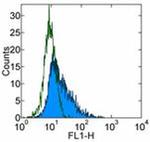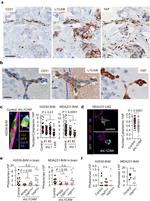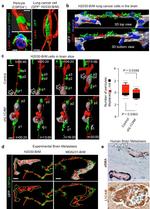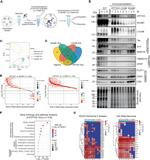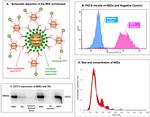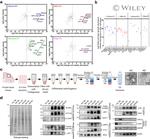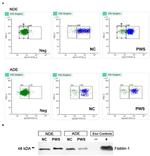Product References
ATP1A3 as a target for isolating neuron-specific extracellular vesicles from human brain and biofluids.
Science advances
You Y,Zhang Z,Sultana N,Ericsson M,Martens YA,Sun M,Kanekiyo T,Ikezu S,Shaffer SA,Ikezu T
Published figure using CD171 monoclonal antibody (Product # 14-1719-82) in Immunoprecipitation
Fri Sep 15 00:00:00 UTC 2023
ATP1A3 as a target for isolating neuron-specific extracellular vesicles from human brain and biofluids.
Science advances
You Y,Zhang Z,Sultana N,Ericsson M,Martens YA,Sun M,Kanekiyo T,Ikezu S,Shaffer SA,Ikezu T
Published figure using CD171 monoclonal antibody (Product # 14-1719-82) in Immunoprecipitation
Fri Sep 15 00:00:00 UTC 2023
Magnetic Separation of Cell-Secreted Vesicles with Tailored Magnetic Particles and Downstream Applications.
Methods in molecular biology (Clifton, N.J.)
Bernuz M,Pallarès-Rusiñol A,Rossi R,Fernández-Senac C,Martí M,Pividori MI
14-1719-82 was used in Flow Cytometry to describe the separation and preconcentration in magnetic particles of extracellular vesicles obtained from cell culture supernatants from MCF7, MDA-MB-231, and SKBR3 breast cancer cell lines, human fetal osteoblastic cell line (hFOB), and human neuroblastoma SH-SY5Y cell line, as well as exosomes from human serum.
Mon May 08 00:00:00 UTC 2023
Magnetic Separation of Cell-Secreted Vesicles with Tailored Magnetic Particles and Downstream Applications.
Methods in molecular biology (Clifton, N.J.)
Bernuz M,Pallarès-Rusiñol A,Rossi R,Fernández-Senac C,Martí M,Pividori MI
14-1719-82 was used in Flow Cytometry to describe the separation and preconcentration in magnetic particles of extracellular vesicles obtained from cell culture supernatants from MCF7, MDA-MB-231, and SKBR3 breast cancer cell lines, human fetal osteoblastic cell line (hFOB), and human neuroblastoma SH-SY5Y cell line, as well as exosomes from human serum.
Mon May 08 00:00:00 UTC 2023
Magnetic Separation of Cell-Secreted Vesicles with Tailored Magnetic Particles and Downstream Applications.
Methods in molecular biology (Clifton, N.J.)
Bernuz M,Pallarès-Rusiñol A,Rossi R,Fernández-Senac C,Martí M,Pividori MI
14-1719-82 was used in Flow Cytometry to describe the separation and preconcentration in magnetic particles of extracellular vesicles obtained from cell culture supernatants from MCF7, MDA-MB-231, and SKBR3 breast cancer cell lines, human fetal osteoblastic cell line (hFOB), and human neuroblastoma SH-SY5Y cell line, as well as exosomes from human serum.
Mon May 08 00:00:00 UTC 2023
Multiplexing Biosensor for the Detection of Extracellular Vesicles as Biomarkers of Tissue Damage and Recovery after Ischemic Stroke.
International journal of molecular sciences
Picciolini S,Mangolini V,Rodà F,Montesano A,Arnaboldi F,Liuzzi P,Mannini A,Bedoni M,Gualerzi A
14-1719-82 was used in ChIP assay to identify a panel of EV-associated molecules that (i) confirm the crucial involvement of EVs in the processes that follow ischemic stroke, (ii) could possibly profile ischemic stroke patients at the beginning of the rehabilitation program, (iii) could be used in predicting patients' response to treatment.
Thu Apr 27 00:00:00 UTC 2023
Microglial-Targeted nSMase2 Inhibitor Fails to Reduce Tau Propagation in PS19 Mice.
Pharmaceutics
Huang M,Tallon C,Zhu X,Huizar KDJ,Picciolini S,Thomas AG,Tenora L,Liyanage W,Rodà F,Gualerzi A,Kannan RM,Bedoni M,Rais R,Slusher BS
14-1719-82 was used in SPRi array to assess D-DPTIP's brain localization.
Thu Sep 21 00:00:00 UTC 2023
Neuronally-enriched exosomal microRNA-27b mediates acute effects of ibuprofen on reward-related brain activity in healthy adults: a randomized, placebo-controlled, double-blind trial.
Scientific reports
Burrows K,Figueroa-Hall LK,Kuplicki R,Stewart JL,Alarbi AM,Ramesh R,Savitz JB,Teague TK,Risbrough VB,Paulus MP
Published figure using CD171 monoclonal antibody (Product # 14-1719-82) in Western Blot
Mon Jan 17 00:00:00 UTC 2022
Evaluation of blood-based, extracellular vesicles as biomarkers for aging-related TDP-43 pathology.
Alzheimer's & dementia (Amsterdam, Netherlands)
Winston CN,Sukreet S,Lynch H,Lee VM,Wilcock DM,Nelson PT,Rissman RA
Published figure using CD171 monoclonal antibody (Product # 14-1719-82) in Flow Cytometry
Wed Jun 07 00:00:00 UTC 2023
Human neural cell type-specific extracellular vesicle proteome defines disease-related molecules associated with activated astrocytes in Alzheimer's disease brain.
Journal of extracellular vesicles
You Y,Muraoka S,Jedrychowski MP,Hu J,McQuade AK,Young-Pearse T,Aslebagh R,Shaffer SA,Gygi SP,Blurton-Jones M,Poon WW,Ikezu T
14-1719-82 was used in Western Blotting to identify cell type-specific extracellular vesicle (EV) protein markers in human-induced pluripotent stem cell-derived neural cell types, including excitatory neurons (ATP1A3, NCAM1), astrocytes (LRP1, ITGA6), microglia-like cells (ITGAM, LCP1), and oligodendrocyte-like cells (LAMP2, FTH1), along with 16 pan-EV marker candidates.
Sat Jan 01 00:00:00 UTC 2022
Human neural cell type-specific extracellular vesicle proteome defines disease-related molecules associated with activated astrocytes in Alzheimer's disease brain.
Journal of extracellular vesicles
You Y,Muraoka S,Jedrychowski MP,Hu J,McQuade AK,Young-Pearse T,Aslebagh R,Shaffer SA,Gygi SP,Blurton-Jones M,Poon WW,Ikezu T
14-1719-82 was used in Western Blotting to identify cell type-specific extracellular vesicle (EV) protein markers in human-induced pluripotent stem cell-derived neural cell types, including excitatory neurons (ATP1A3, NCAM1), astrocytes (LRP1, ITGA6), microglia-like cells (ITGAM, LCP1), and oligodendrocyte-like cells (LAMP2, FTH1), along with 16 pan-EV marker candidates.
Sat Jan 01 00:00:00 UTC 2022
Insulin receptor substrate in brain-enriched exosomes in subjects with major depression: on the path of creation of biosignatures of central insulin resistance.
Molecular psychiatry
Nasca C,Dobbin J,Bigio B,Watson K,de Angelis P,Kautz M,Cochran A,Mathé AA,Kocsis JH,Lee FS,Murrough JW,McEwen BS,Rasgon N
Published figure using CD171 monoclonal antibody (Product # 14-1719-82) in Western Blot
Wed Sep 01 00:00:00 UTC 2021
Neuronal and Astrocytic Extracellular Vesicle Biomarkers in Blood Reflect Brain Pathology in Mouse Models of Alzheimer's Disease.
Cells
Delgado-Peraza F,Nogueras-Ortiz CJ,Volpert O,Liu D,Goetzl EJ,Mattson MP,Greig NH,Eitan E,Kapogiannis D
14-1719-82 was used in Western Blotting to validate extracellular vesicles proteins as Alzheimer''s disease biomarkers.
Fri Apr 23 00:00:00 UTC 2021
Neuronal and Astrocytic Extracellular Vesicle Biomarkers in Blood Reflect Brain Pathology in Mouse Models of Alzheimer's Disease.
Cells
Delgado-Peraza F,Nogueras-Ortiz CJ,Volpert O,Liu D,Goetzl EJ,Mattson MP,Greig NH,Eitan E,Kapogiannis D
14-1719-82 was used in Western Blotting to validate extracellular vesicles proteins as Alzheimer''s disease biomarkers.
Fri Apr 23 00:00:00 UTC 2021
Plasma Levels of Neuron- and Astrocyte-Derived Exosomal Amyloid Beta1-42, Amyloid Beta1-40, and Phosphorylated Tau Levels in Schizophrenia Patients and Non-psychiatric Comparison Subjects: Relationships With Cognitive Functioning and Psychopathology.
Frontiers in psychiatry
Lee EE,Winston-Gray C,Barlow JW,Rissman RA,Jeste DV
Published figure using CD171 monoclonal antibody (Product # 14-1719-82) in Flow Cytometry
Sat Mar 27 00:00:00 UTC 2021
Pericyte-like spreading by disseminated cancer cells activates YAP and MRTF for metastatic colonization.
Nature cell biology
Er EE,Valiente M,Ganesh K,Zou Y,Agrawal S,Hu J,Griscom B,Rosenblum M,Boire A,Brogi E,Giancotti FG,Schachner M,Malladi S,Massagué J
14-1719-82 was used in Immunohistochemistry to identify an important step in the initiation of metastatic colonization, define its molecular constituents and provide an explanation for the widespread association of L1CAM with metastatic relapse in the clinic.
Wed Aug 01 00:00:00 UTC 2018
Pericyte-like spreading by disseminated cancer cells activates YAP and MRTF for metastatic colonization.
Nature cell biology
Er EE,Valiente M,Ganesh K,Zou Y,Agrawal S,Hu J,Griscom B,Rosenblum M,Boire A,Brogi E,Giancotti FG,Schachner M,Malladi S,Massagué J
14-1719-82 was used in Immunohistochemistry to identify an important step in the initiation of metastatic colonization, define its molecular constituents and provide an explanation for the widespread association of L1CAM with metastatic relapse in the clinic.
Wed Aug 01 00:00:00 UTC 2018
